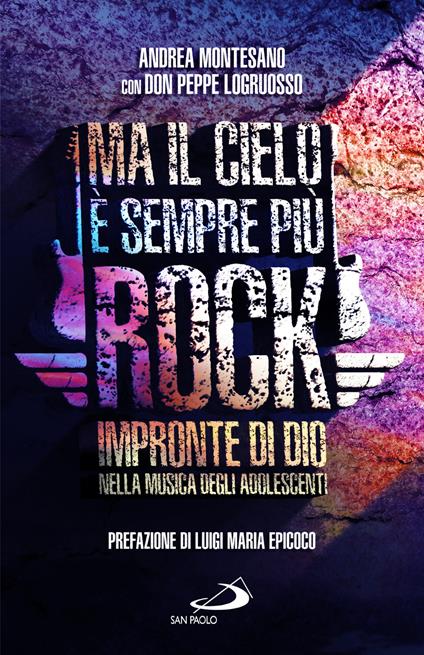In the book “But the sky is more and more rock. Footprints of God in the music of adolescents” the authors try to combine three major themes: psychology, spirituality and music to penetrate the complex world of adolescents. The example of the Trap genre
It was released on August 29th in bookstores “But the sky is more and more rock. Footprints of God in the music of adolescents ”by Andrea Montesano And don Peppe Logruosso (San Paolo Editions) with the preface by Don Luigi Maria Epicoco.
Music: access key to the world of adolescents
They try to combine three major themes: psychology, spirituality and music to find a key able to penetrate the complex world of teenagers. The project is very ambitious, some would say reckless, and the authors themselves are absolutely aware of it.
Through a path dotted with songs that have made or make history, Montesano and Logruosso have used music as a vehicle to go deeper where it seems impossible to arrive, to deciphering adolescent psychology and offer a reading in terms of aspiration to the immaterial.
The aspects covered are many, and it is not possible to account for them in a single presentation. Therefore we have chosen to propose some reflections related to the chapter on Trap music (from page 96), which also exemplifies the great effort made by the authors to give substance to their work.
“Where there is music, there is also the spirit”
Once you have managed to penetrate the deepest experiences of each one – says Don Peppe – the songs can become a daily exercise of spirituality, a valid tool to immerse yourself in an intimate and precious nucleus that takes the name of the unconscious. Where there is music, therefore, there is also the spirit.
Music represents for children themaximum expression of freedom and imagination, enclosing within itself the ideals, desires and fantasies of every teenager:
(…) It was like that in Elvis’ time, it is like that today with Achille Lauro. Due to its strongly cultural matrix, music is the background, from generation to generation, for the everyday life of young people who feel the strong need to belong “freely” to an identifying musical style to say what they think and enclose dreams and feelings in it. Music, for today’s teenagers, is a daily dimension, with which to live together and through which to talk about oneself. The music of “today’s” kids is Trap music.
The music of “today’s” kids is Trap music
It starts from Rap, but abandons both the social themes present in the latter and the storytelling of the ghetto, focusing instead on:
(…) four or five issues, declined to the point of obsession: the search for money as the only possible ransom, suburban identity, gangsta attitudes and the good life, nights in clubs, expensive cars, drugs, ‘gold as a status symbol of “I did it” »(Rosa, 2018).
In the transition from Rap to Trap …
(…) The utopia of a protest able to tell, in a free way, the difficult and controversial life as it originally happened in Rap is shattered. Through the American sound of the Gangsta Rap of the early 90s, the Trap brings with it all the trash (literally meant as garbage) of themes full of violence (an end in itself), misogynistic and sexist attitudes, vulgarity and a frantic search for wealth. (sparkling) and luxury (unbridled).
Drugs and Trap Music
Drug is one of the main elements present either in the texts that in the video clips of young trappers.
The adolescent equation “music (Trap) + drugs = transgression” when and in cases where it becomes such, should awaken the consciences of educational agents in order to grasp the messages of discomfort that young people unconsciously communicate. Every parent or educator, in fact, should have a minimum of knowledge regarding the musical tastes of “their” adolescents and the main psychoactive substances, as well as the awareness of what consequences “the abuse of music” could lead to in such a delicate phase.
Trap music: mirror of adolescent emptiness
Knowing this musical genre is essential for those who want to understand how much is stirred within adolescent experiences expressed in their immediacy through the music that the children listen to.
Trap music is experienced and chewed by the people of children, because in fact it proposes all the communication models of the network in which they themselves live, because for some years now the network is no longer entered, the network is inhabited. Those models of reference have characteristics of anger, negativity, fragmentation and unbridled emulations, where the focus of the listener is not on the personal growth of oneself in a construction of meaning in what one hears, but is reduced to the passive choice of belonging to the herd of followers who hypnotically let themselves be carried away by the current of liquid music.

Trap a challenge for adults
For most adults, parents first, the first reaction listening to Trap music is that of disgust and absolute rejection. But whoever approaches these issues with the aim of understanding the adolescent world for weave a dialogue, and help the kids catch a glimpse of one perspective of sense to one’s life, must allow …
(…) The adolescent to make his own musical choices “freely” then supporting him in the constructive dialogue that can determine the reason for one choice rather than another, thus activating those stimuli for reflection contained within Trap music. The secret, always keeping the educational alliance dimension vigilant, then remains that of developing a critical and non-judgmental attitude with respect to the choices and decisions of the child, which become meaningful for him regardless of what matters to those who find him. in front of.

San Paolo Editions
Does your child listen to Trap music? if you don’t demonize it it can help you understand it

